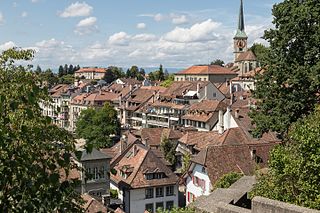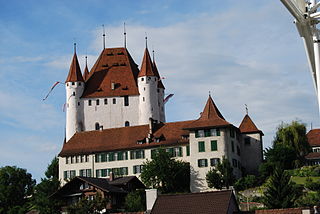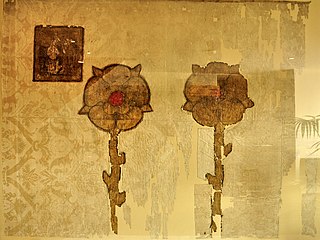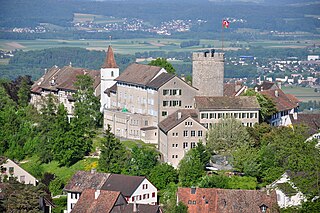
The House of Zähringen was a dynasty of Swabian nobility. The family's name derived from Zähringen Castle near Freiburg im Breisgau. The Zähringer in the 12th century used the title of Duke of Zähringen, in compensation for having conceded the title of Duke of Swabia to the Staufer in 1098. The Zähringer were granted the special title of Rector of Burgundy in 1127, and they continued to use both titles until the extinction of the ducal line in 1218.

The canton of Bern, or Berne, is one of the 26 cantons forming the Swiss Confederation. Its capital city, Bern, is also the de facto capital of Switzerland. The bear is the heraldic symbol of the canton, displayed on a red-yellow background.

Winterthur is a city in the canton of Zürich in northern Switzerland. With over 120,000 residents, it is the country's sixth-largest city by population, as well as its ninth-largest agglomeration with about 140,000 inhabitants. Located about 20 kilometres (12 mi) northeast of Zürich, Winterthur is a service and high-tech industrial satellite city within Greater Zürich.

Burgdorf is the largest city in the Emmental in the canton of Bern in Switzerland. It was the capital of the district of the same name until 2010, when it became part of the new Emmental district.

Lenzburg Castle is a castle located above the old part of the town of Lenzburg in the Canton of Aargau, Switzerland. It ranks among the oldest and most important of Switzerland. The castle stands on the almost circular castle hill, which rises approximately 100 m (330 ft) over the surrounding plain but is only about 250 m (820 ft) in diameter. The oldest parts of the castle date to the 11th century, when the Counts of Lenzburg built it as their seat. The castle, its historical museum and the castle hill with its Neolithic burial grounds are listed as heritage sites of national significance.

The counts of Toggenburg ruled the Toggenburg region of today's canton of St. Gallen, Switzerland, and adjacent areas during the 13th to 15th centuries.

Kyburg Castle is a castle in Switzerland, overlooking the Töss river about 3 km south-east of Winterthur, in Kyburg municipality, canton of Zürich. It is a Swiss heritage site of national significance.

The Zürcher Oberland in Switzerland, is the hilly south-eastern part of the canton of Zürich, bordering on the Toggenburg, including the districts of Uster, Hinwil, Pfäffikon as well as the Töss Valley as far as the district of Winterthur. The territory gradually fell under the control of the city of Zürich from 1408 to 1452. In the 18th century, the jurisdiction lay with the reeve of Grüningen for the southern part, and with the reeve of Kyburg for the northern part together with most of the Zürcher Unterland.
The Kyburg family was a noble family of grafen (counts) in the Duchy of Swabia, a cadet line of the counts of Dillingen, who in the late 12th and early 13th centuries ruled the County of Kyburg, corresponding to much of what is now Northeastern Switzerland.

The Burgdorferkrieg or Kyburgerkrieg was a war in 1383-84 between the counts of Neu-Kyburg and the city of Bern for supremacy in the County of Burgundy in what is now Switzerland.

Burgdorf Castle is a castle in the municipality of Burgdorf in the canton of Bern in Switzerland. It is a Swiss heritage site of national significance.

Thun Castle is a castle in the city of Thun, in the Swiss canton of Bern. It was built in the 12th century, today houses the Thun Castle museum, and is a Swiss heritage site of national significance.

The Counts of Lenzburg were a comital family in the Duchy of Swabia in the 11th and 12th centuries, controlling substantial portions of the pagi of Aargau and Zürichgau.

Töss Monastery was a community of Dominican nuns located in the former Swiss city of Töss, now a part of Winterthur. Nothing of the original buildings exists today.

The House of Rapperswil respectively Counts of Rapperswil ruled the upper Zürichsee and Seedamm region around Rapperswil and parts of, as of today, Swiss cantons of St. Gallen, Glarus, Zürich and Graubünden when their influence was most extensive around the 1200s until the 1290s. They acted also as Vogt of the most influential Einsiedeln Abbey in the 12th and 13th century, and at least three abbots of Einsiedeln were members of Rapperswil family.

Regensberg Castle is a hill castle which was built about the mid-13th century AD by the House of Regensberg in the Swiss municipality of Regensberg in the Canton of Zürich.
The Regensberg family was a family of counts from the Canton of Zürich in Switzerland. They had possessions in the medieval Zürichgau from the probably mid-11th century and became extinct in 1331 AD. With the extinction of the male line, the city republic of Zürich laid claim to the Regensberg lands and formed the Herrschaft Regensberg respectively Äussere Vogtei.

The Thurgau was a pagus of the Duchy of Alamannia in the early medieval period. A County of Thurgau existed from the 13th century until 1798. Parts of Thurgau were acquired by the Old Swiss Confederacy during the early 15th century, and the entire county passed to the Confederacy as a condominium in 1460.

The Counts of Dillingen were a Swabian comital family of the Hupaldinger (Hucpaldinger) dynasty during AD 955–1286.




















